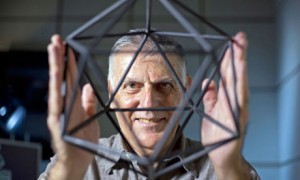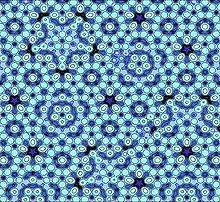 Dan Shechtman, the Nobel prize-winning scientist, has been profiled in Guardian, it is worth a read. In fact it is always worth digging into any such profile for any of the science prize winners, they are always quite interesting, and this is no exception. If you are a regular reader of this blog you will know that I don’t feel the same way about the Nobel Peace prize winners, ah but that is another story, so lets move on and focus on Professor Shechtman.
Dan Shechtman, the Nobel prize-winning scientist, has been profiled in Guardian, it is worth a read. In fact it is always worth digging into any such profile for any of the science prize winners, they are always quite interesting, and this is no exception. If you are a regular reader of this blog you will know that I don’t feel the same way about the Nobel Peace prize winners, ah but that is another story, so lets move on and focus on Professor Shechtman.
He is the Philip Tobias Professor of Materials Science at the Technion – Israel Institute of Technology, an Associate of the US Department of Energy’s Ames Laboratory, and Professor of Materials Science at Iowa State University, but what he truly made his name with is the new field of quasiperiodic crystals, in fact he started it all.
 What exactly are quasicrystals?
What exactly are quasicrystals?
In quasicrystals, we find the fascinating mosaics of the Arabic world reproduced at the level of atoms: regular patterns that never repeat themselves. However, the configuration found in quasicrystals was considered impossible, and Dan Shechtman had to fight a fierce battle against established science. The Nobel Prize in Chemistry 2011 has fundamentally altered how chemists conceive of solid matter.
On the morning of 8 April 1982, while on sabbatical at the U.S. National Bureau of Standards inWashington, D.C., an image counter to the laws of nature appeared in Dan Shechtman’s electron microscope. In all solid matter, atoms were believed to be packed inside crystals in symmetrical patterns that were repeated periodically over and over again. For scientists, this repetition was required in order to obtain a crystal.
Shechtman’s image, however, showed that the atoms in his crystal were packed in a pattern that could not be repeated. Such a pattern was considered just as impossible as creating a football using only six-cornered polygons, when a sphere needs both five- and six-cornered polygons. His discovery was extremely controversial. In the course of defending his findings, he was asked to leave his research group. However, his battle eventually forced scientists to reconsider their conception of the very nature of matter.
Aperiodic mosaics, such as those found in the medieval Islamic mosaics of the Alhambra Palace in Spain and the Darb-i Imam Shrine in Iran, have helped scientists understand what quasicrystals look like at the atomic level. In those mosaics, as in quasicrystals, the patterns are regular – they follow mathematical rules – but they never repeat themselves.
When scientists describe Shechtman’s quasicrystals, they use a concept that comes from mathematics and art: the golden ratio. This number had already caught the interest of mathematicians in Ancient Greece, as it often appeared in geometry. In quasicrystals, for instance, the ratio of various distances between atoms is related to the golden mean.
Following Shechtman’s discovery, scientists have produced other kinds of quasicrystals in the lab and discovered naturally occurring quasicrystals in mineral samples from a Russian river. A Swedish company has also found quasicrystals in a certain form of steel, where the crystals reinforce the material like armor. Scientists are currently experimenting with using quasicrystals in different products such as frying pans and diesel engines.
Where can I find out more about quasicrystals?
Here …
- Lifshitz, R., Introduction to quasicrystals, http://www.tau.ac.il/~ronlif/quasicrystals.html
- Shechtman, D. (2010) Quasicrystals, a new form of matter, http://www.youtube.com/watch?v=EZRTzOMHQ4s
- Senechal, M. (2011) Quasicrystals gifts to mathematics, http://www.youtube.com/watch?v=pjao3H4z7-g&feature=relmfu
- Steurer, W. (2011) Fascinating quasicrystals, http://www.youtube.com/watch?v=jM4AIipGOdk
- Steinhardt, P.J., What are quasicrystals?, http://www.physics.princeton.edu/~steinh/QuasiIntro.ppt
So when did he win the Nobel Prize, and what are the details?
He was the sole winner of the Nobel Prize for Chemistry in 2011, so not too long ago, and to have the prize to yourself means it was a big event. Well it was, that discovery in the 1980s changed chemistry. The Guardian profile gives us more insights into the discovery and what went on (this is where it becomes really interesting), he met a considerable degree of resistance, what he had discovered was so at odds with what was then known, that many refused to accept it and so labelled him “wrong wrong wrong” …
In April 1982, Shechtman was on sabbatical at America’s National Institute of Standards and Technology, when he saw something curious through his electron microscope. “Eyn chaya kazo,” he said to himself (“there can be no such creature” in Hebrew). He had been studying a rapidly cooled mix of aluminium and manganese, an alloy with potential uses in aerospace technologies, and saw something that was forbidden according to known chemistry. The atoms in the sample seemed to be arranged in a pattern that had a five-fold rotational symmetry.
The atoms in a solid material are arranged in an orderly fashion and that order is usually periodic and will have a particular rotational symmetry. A square arrangement, for example, has four-fold rotational symmetry – turn the atoms through 90 degrees and it will look the same. Do this four times and you get back to its start point. Three-fold symmetry means an arrangement can be turned through 120 degrees and it will look the same. There is also one-fold symmetry (turn through 360 degrees), two-fold (turn through 180 degrees) and six-fold symmetry (turn through 60 degrees). Five-fold symmetry is not allowed in periodic crystals and nothing beyond six, purely for geometric reasons.
Shechtman’s results were so out of the ordinary that, even after he had checked his findings several times, it took two years for his work to get published in a peer-reviewed journal. Once it appeared, he says, “all hell broke loose”.
Many scientists thought that Shechtman had not been careful enough in his experiments and that he had simply made a mistake. “The bad reaction was the head of my laboratory, who came to my office one day and, smiling sheepishly, put a book on x-ray diffraction on my desk and said, ‘Danny, please read this book and you will understand that what you are saying cannot be.’ And I told him, you know, I don’t need to read this book, I teach at the Technion, and I know this book, and I’m telling you my material is not in the book.
“He came back a couple of days later and said to me, ‘Danny, you are a disgrace to my group. I cannot be with you in the same group.’ So I left the group and found another group that adopted a scientific orphan.”
He says that the experience was not as traumatic as it sounded. Scientists around the world had quickly replicated Shechtman’s discovery and, in 1992, the International Union of Crystallography accepted that quasi-periodic materials must exist and altered its definition of what a crystal is from “a substance in which the constituent atoms, molecules or ions are packed in a regularly ordered, repeating three-dimensional pattern” to the broader “any solid having an essentially discrete diffraction diagram”.
That should have been the end of the story were it not for Linus Pauling, a two-time Nobel laureate, once for chemistry and a second time for peace. Shechtman explains that at a science conference in front of an audience of hundreds Pauling claimed, “Danny Shechtman is talking nonsense, there are no quasi-crystals, just quasi-scientists.”
Pauling told everyone who would listen that Shechtman had made a mistake. He proposed his own explanations for the observed five-fold symmetry and stuck to his guns, despite repeated rebuttals. “Everything he did was wrong and wrong and wrong and wrong; eventually, he couldn’t publish his papers and they were rejected before they were published,” says Shechtman. “But he was very insistent, was very sure of himself when he spoke; he was a flamboyant speaker.”
Lesley Yellowlees, president of the Royal Society of Chemistry, said that fundamental science was about breaking through the boundaries of knowledge and sometimes that means pursuing an idea that others think is just too unbelievable to be true. “Dan Shechtman’s Nobel prize celebrated not only a fascinating and beautiful discovery, but also dogged determination against the closed-minded ridicule of his peers, including leading scientists of the day. His prize didn’t just reward a difficult but worthy career in science; it put the huge importance and value of funding basic scientific research in the spotlight.”
In the end, the science won out, others reproduced his results and confirmed it. When belief, in this case belief that it just could not be so, goes head-to-head with evidence based science, then science wins, and that is why science trumps everything else, in the face of new information it will change.
Questions
The Guardian folks could not resist asking him a few questions on other topics, and luckily they asked him several sensible ones …
What is the most exciting field of science at the moment? Biology and medical sciences.
Do you believe in a god? No.
What book about science should everyone read? The Structure of Scientific Revolutions by Thomas S Kuhn.
Has Cern been worth the money? Definitely yes. The frontiers of science, on the very small scale and very large scale, require large investments and international effort. If we really want to understand the laws of physics – and we do – we need these investments made.
What advice would you give a teenager who wants a career in science? Select a subject that interests you and make an effort to become an expert in that field. I promise you, if you make the effort, and you become an expert, you will have a wonderful career.
What scientific advance would make the most difference to your daily life?
The development of new effective drugs, new efficient batteries and clean, inexpensive energy sources.
Are you worried about population increase? Not at all. The good news is world population growth rate decreases systematically and is expected to reach zero by 2050, thanks to urbanisation and women’s education. The bad news is while in most developed countries the number of children per woman is 1 to 1.5, that number in many developing countries is 6-7.
If politicians were replaced by scientists, would the world be better place? No, both politics and science would suffer.
Interview
Here is an interview with him just after he won the Nobel Prize.